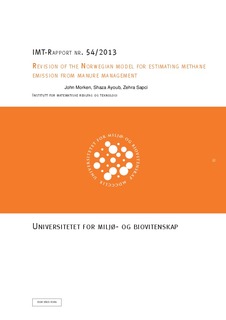| dc.contributor.author | Morken, John | |
| dc.contributor.author | Ayoub, Shaza | |
| dc.contributor.author | Sapci, Zehra | |
| dc.date.accessioned | 2015-03-04T13:06:44Z | |
| dc.date.available | 2015-03-04T13:06:44Z | |
| dc.date.issued | 2015-03-04 | |
| dc.identifier.issn | 1503-9196 | |
| dc.identifier.uri | http://hdl.handle.net/11250/278449 | |
| dc.description.abstract | Det internasjonale klimapanelet (IPCC) har lagd modeller for beregning av metanutslipp fra gjødselhandtering. Modellene fra IPCC blir brukt til å beregne og rapportere utslippene årlig til United Nations Framework Convention on Climate Change. Målet med rapporten er å foreslå endringer av faktorer brukt i de norske beregningene. Dels er forslaget basert på egne målinger av potensielt utslipp, såkalt B0-faktor (storfe, gris, hest), dels på litteraturvurderinger (resten av dyr). Metanproduksjon avhenger av gjødselproduksjonen fra dyrene, og vi forslår å basere disse beregningene på modeller utarbeidet av institutt for Akvakultur og Husdyrfag (UMB). Utslippsmodellen inneholder en faktor (MCF) for hvor stor andel av potensiell produksjon som blir emittert som metan. Rapporten foreslår å bruke tall fra Sverige i stedet for «default»-verdiene fra IPCC. Dette vil bety rapporterte reduserte utslipp. Videre foreslår vi at man bruker statistikk som SSB har over husdyrgjødselsystemer (manure management) til å kvantifisere hvor stor andel av gjødsel fra respektive dyr blir lagret som bløtgjødsel og fastgjødsel, samt hvor stor andel av gjødsla som lagres. | nb_NO |
| dc.description.abstract | The goal of this paper is to revise the factors used by Statistics Norway (SSB) to predict the methane emission from manure management under Norwegian conditions. The Tier 2 IPCC model for calculating methane emission from manure management includes evaluations of volatile solids produced per animal, biogas potential, factors related to the amount of the potential that will be utilized, and also the type of manure management. We have conducted research on biogas potentials for dairy cows, pig, and horses. The potential were estimated at 230 (average of 5 cows), 291, and 261 (ml/g VS) for dairy cows, pigs, and horses respectively. Based on available literature we suggest using 230 and 300 (ml/g VS) for dairy cows and pigs respectively. For horses we suggest that the default value of IPCC is used due to the limited number of studies supporting our findings. Estimation of volatile solids from estimations of the production of dry matter per animal are proposed. Utilization factors (so called MCF) were evaluated according to projects that were carried out in Sweden, and in this paper we propose factors for Norway based on these figures. These factors are also suggested by Statistics Sweden. The biggest difference is MCF factors for liquid manure (3.5% instead of 8% in earlier calculations). We also suggest that information on manure management systems should be used in the calculations, while the calculation method for volatile solids should be based on the estimation method of dry matter production per animal proposed by the Department of husbandry and aquaculture, Norwegian University of Life Sciences. | |
| dc.language.iso | eng | nb_NO |
| dc.relation.ispartofseries | IMT Rapport;54/2013 | |
| dc.rights | Navngivelse 3.0 Norge | * |
| dc.rights.uri | http://creativecommons.org/licenses/by/3.0/no/ | * |
| dc.subject | Landbruk | nb_NO |
| dc.subject | Husdyrgjødselhandtering | nb_NO |
| dc.subject | Metanemisjon | nb_NO |
| dc.subject | Beregning | nb_NO |
| dc.subject | Agricultural | nb_NO |
| dc.subject | Manure management | nb_NO |
| dc.subject | Methane emission | nb_NO |
| dc.subject | Calculation | nb_NO |
| dc.title | Revision of the Norwegian model for estimating methane emission from manure management | nb_NO |
| dc.type | Research report | nb_NO |
| dc.subject.nsi | VDP::Technology: 500::Environmental engineering: 610 | nb_NO |
| dc.source.pagenumber | 10 | nb_NO |
| dc.relation.project | Statens Landbruksforvaltning og Miljødirektoratet | nb_NO |

